
Background
Glendale is a city of 204765 people (as of 2019) in Los Angeles County, California, located 16km/10mi north of downtown Los Angeles and 11km/7mi west of Pasadena.

Running through Glendale is the Ventura County Line, a 114km/71mi non-electrified main line used mostly for regional commuter trains. The line is largely owned by the local LA Metropolitain Transport Authority.

The vehicles involved
Mister Álvarez was driving an early model Jeep Cherokee XJ, a two-door 4x4 (although it is at times considered an early SUV) made between 1984 and 1996. The Cherokee features unibody construction, rather than the “body on frame”-construction of its predecessor. The car weighs 1.5 metric tons empty at 4.19m/13.7ft in length.

Travelling southbound towards downtown Los Angeles was Metrolink train number 100, consisting of a first generation Bombardier bilevel passenger car, a third-generation car of the same series and a first-generation bilevel passenger cab car (also referred to as control cars). Each car weighs 50 metric tons empty at 25.9m/85ft long and 4.85m/15ft high. The standard cars can seat 136 to 162 passengers depending on the equipment/configuration, with the cab cars featuring a full driver’s cab built into one end to allow remote control of the locomotive. This allows operation in push-pull configuration, meaning at the end of the journey the locomotive doesn’t need to be moved to the other end of the train. It will pull the train into the station, the driver exits and walks down the length of the train, remote-controlling the locomotive from the cab car to push the train out of the station in the opposite direction.The cab cars used by Metrolink at the time featured next to no indication of the cab from the outside apart from small headlights, making it look like the train was actually just reversing at random. The exact number of passengers isn’t known, but train #100 usually carried around 220 people at that time of day.

Pushing train #100 at the time of the accident was Metrolink locomotive number 873, an EMD F59PH made in 1993. The F59PH is a 17.73m/58ft long four-axle diesel locomotive developed specifically for regional passenger trains. They feature a 2200kW/3000hp turbocharged two-stroke diesel engine allowing the 118 metric ton locomotive to reach a top speed of 134kph/83mph.

Coming the other way heading out of downtown Los Angeles was Metrolink train number 903, also consisting of three bilevel passenger cars. Opposite to train #100 train #903 was being pulled at the time and was made up of a second generation Bombardier bilevel car and a first generation one, with a first generation cab car on the trailing end. Pulling the train at the time of the accident was Metrolink locomotive number 886, an EMD F59PHI. Introduced in 1994 the PHI-version is an improvement upon the F59PH, easily distinguishable by the body being clad in streamlined fiberglass covers to improve aerodynamics and give the locomotive a more modern appearance. Its engine, based off the F59PH’s one, received a bump in power to 2400kW/3200hp, allowing the 120.2 metric ton locomotive a top speed of 177kph/110mph. At the time of day the train usually carried around 40 people, being near-empty as it ran against the main direction of traffic.
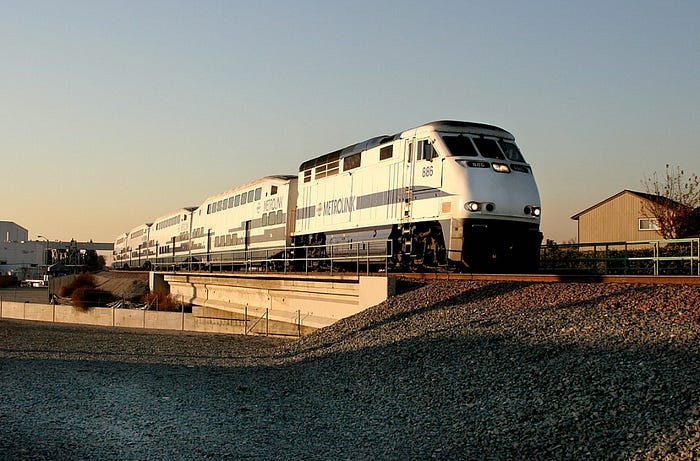
Parked up on a siding near Magnolia Avenue was WGSVTD-18 (from here on referred to as “the freight train”), a row of ballast cars carrying gravel led by two Union Pacific locomotives. The leading locomotive was UP4323 (the second one’s number is unknown), a EMD SD70M. The EMD SD70M is a six-axle multipurpose diesel locomotive made between 1992 and 2004. The SD70M measures 22m/72ft in length at a weight of 184.6 metric tons. Powered by a V16 diesel engine putting out 2982kw/4000hph, enough for a top speed of 112kph/70mph. As it sat on the siding, parked and brakes applied, it presented little but a massive steel block.

The accident
On the 26th of January 2005 at 6am Metrolink #100 is heading south towards Glendale station on the right hand track with the cab car leading and the locomotive pushing. At 6:02am it crosses Chevy Chase Drive at 63mph. At the same time Metrolink #901 is leaving Glendale station northbound. At 6:03am Metrolink #100 strikes a Jeep Cherokee parked on the tracks at 90° to the trains at full speed. The car, a fraction of the train in weight and size, disintegrates on impact, barely slowing the train. Debris from the Jeep became wedged underneath the leading wheels of the leading car. Still travelling at high speed despite fully applied brakes the train reaches a set of points 275m/900ft south of Chevy Chase drive. The points connect to a siding which holds a parked freight train with gravel for nearby track repairs. The debris pushes the leading wheels of Metrolink #100 into the siding while the rear wheels continue to travel straight ahead. Seconds after the initial collision the cab car strikes the locomotive of the freight train at approximately 76kph/47mph. The impact with the locomotive buckles the frame of the cab car and crushes its body, compressing it by 8m/26ft. The locomotive is lifted up by the passenger train hitting it, tearing off the following locomotive and rotating 30° before falling over into an adjacent parking lot. As the cab car continued to rotate it derailed its following car before tearing off at the coupler, breaching the minimum clearance outline of the northbound track just as Metrolink #901 reaches the site on its northbound journey. The two cars jackknifed, with the cab car of the southbound train reaching the oncoming track almost in reverse alongside the forward-moving second car.
The rear of the cab car and leading left corner of the following passenger car missed the locomotive and leading car of the northbound train, which was travelling at 80kph/50mph, before making contact with the sides of the rear two cars. The first point of contact happened 3m/10ft behind the second car’s forward doors, puncturing the wall of the car and pushing it in all the way to the aisle, destroying several rows of seats before the changing shape of the car’s framing pushed the southbound train car out of the northbound one. As the car leaned to its right due to the collision it misaligned with the trailing cab car, creating what effectively was a broad wall for the southbound train to hit the cab car of the northbound train. The impact into the cab car ripped it off the northbound train, causing severe damage before the cab car fell over and slid to a stop on its right hand side next to the tracks. The rest of the severely damaged northbound train continued on its way for a short distance, coming to a stop further up the tracks due to the torn coupler activating the brakes. 11 people were killed in the accident, with 177 suffering injuries.

Aftermath
The first people at the site were employees of a Costco-Supermarket next to the rail line, who scaled a fence and rendered first aid to survivors. They also spotted a severely injured man near the level crossing, pointing him out to professional responders when those arrived shortly after the accident. The employees also began to climb into the mangled cars to pull out survivors, while others grabbed any fire extinguishers they could find to try and fight smaller fires that had popped up all over the sprawling wreckage caused by spraying fuel coming in contact with hot metal. A few minutes after the witnesses had placed the first calls to emergency services a massive response was set in motion, over 300 responders, several helicopters and a couple of search dogs were involved in the rescue and recovery.
The man whom the responders had spotted near the crossing fled before responders could reach him, he was later identified and responders found him at a friend’s house. The man, Mister Álvarez, was the owner of the Jeep that had started the whole disaster. He had been suicidal, cutting his wrists and inflicting several more stab wounds on himself before driving his car onto the tracks at the crossing and then proceeding down the tracks to the south. Eventually he placed the Jeep at 90° to the track, beaching it on the rails. When he saw the train close in on him he had second thoughts, abandoning the car and barely making it out of the train’s path before the initial collision. Some witnesses initially claim to have seen Álvarez inflict the wounds on himself after the train crash, however these rumors were disproven.

The severe outcome of what was not an unusual accident at the base, cars or trucks get struck by trains quite often, soon drew attention to the trains involved and the type of operation utilized especially for the southbound train. The Bombardier bilevel cars used by Metrolink were an incredibly common model, Metrolink alone had bought over 150 of them. The push-pull operation with leading cab cars for half the train’s use has been commonplace for decades, allowing highly efficient operations and flexibility, no longer needing turntables, track-triangles or sidings to move the locomotive around when a train was meant to change direction. A train could run on a single-track line and turn around at any station.

After the accident criticisms were voiced about the safety of running trains in a pushing configuration, which meant that the train lacked a lot of the rigidity a locomotive possessed in case of an accident. The type of locomotive used in North America for trains like the ones involved is especially rigid in its construction, usually featuring a (nearly) full steel construction with a hood and part of the frame ahead of the locomotive’s cab. To compare, with the end of steam traction in Europe the driver’s cab usually ended up right at the front of the locomotive. This meant that cab cars in North America are even more different in their structure compared to their locomotives than their counterparts in Europe. Seeing the incredible damage inflicted upon the southbound cab car during the crash at Glendale it wasn’t surprising that people voiced criticism towards the operation, seeing it as negligent to lead a train with a car and not the locomotive.

While it can’t be ignored that a locomotive would’ve been more rigid/suffered less compression in the accident than the cab car, it cannot be ignored that this would’ve also meant even worse damage to the northbound train, which already suffered extensive damage from being sideswiped by the southbound train’s control car.
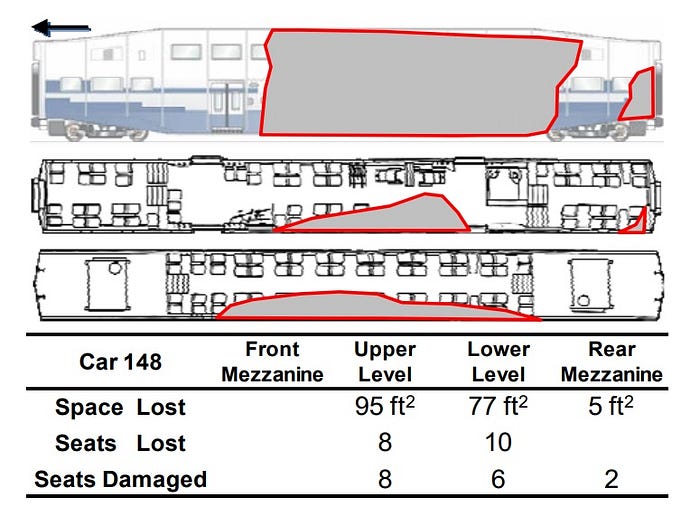
Furthermore, the cab cars used by Metrolink had no structural difference to the regular passenger cars, meaning the cars that often ran at the leading end of a train had the same structural engineering as any other bilevel car. This meant that cars were cheaper to produce and could also be converted back and forth, but it also meant there were no reinforcements or added crumple zones in case of a collision. Outside the US bilevel cars usually featured a dedicated driver’s cab that differed more clearly from the regular passenger cars for the downside of higher cost and the inability to convert the cars back and forth without major changes.
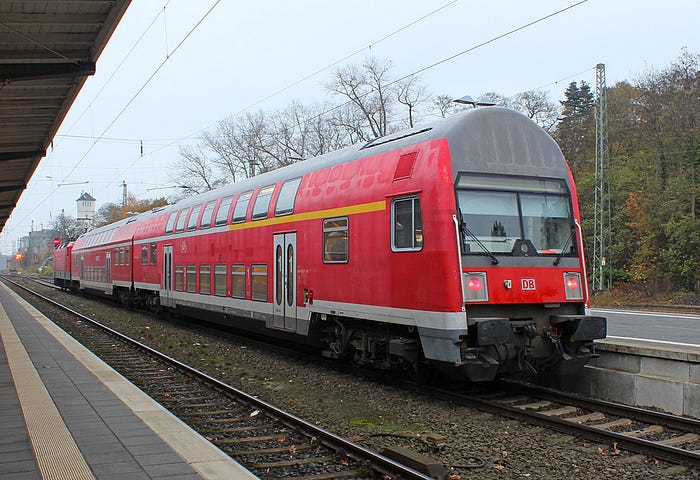
Digging deeper into the construction of the train cars the investigators found a major engineering issue. The train car’s main frame featured a low section in the middle before raising up towards the ends to accommodate the wheels without requiring too much overall height. For this transition the frames feature a diagonal “gooseneck” section, connecting the lower and higher horizontal section of the frame. Digging through the remains of the control car investigators found that these sections lacked bracing, in the accident the goosenecks in the southbound train’s control car first started folding back before breaking completely, aiding the loss of survival space as it allowed the floor of the end sections to move inwards, pushing the stairs into the lower and upper level passenger spaces. When the cab car spun around and struck the northbound train the process was repeated on that side, aided by the structural compression of the car tearing apart vertical connectors between the floors, allowing the upper level to sag down on which compromised survival space on the lower level even more.


In the end, while the accident was without a doubt caused by Mister Álvarez’ attempted and then aborted suicide, the investigation couldn’t go without shining a light on the train car’s problematic structural engineering. They had to be careful in their wording, pointing out the problems with this kind of train car without confirming the criticism that anything but a locomotive-pulled train is unsafe. The forces inflicted on the southbound train when it derailed and struck the parked freight train were beyond imagination, it was a real life case of “unstoppable force meets immovable object”. But the extreme example showed problems with the engineering of the train cars that could be translated to smaller scale accidents. It was decided that new cab cars had to feature proper driver’s cabs with crash engineering similar to that of locomotives, rather than (in simplified terms) “just sticking a control desk in there”.
The day after the accident police were called to an attempted suicide in nearby Irvine, California, where a suicidal man had parked on Metrolink tranks. When the police arrived the man fled, after a later arrest he admitted to have seen the Metrolink crash the prior day and that his attempt was a copycat-attempt of sorts as he’d seen the “efficiency” of it.
Metrolink banned passengers from riding in the leading cab cars starting the day after the accident, by 2007 they changed this to only roping off the leading section if the cab car led the train.
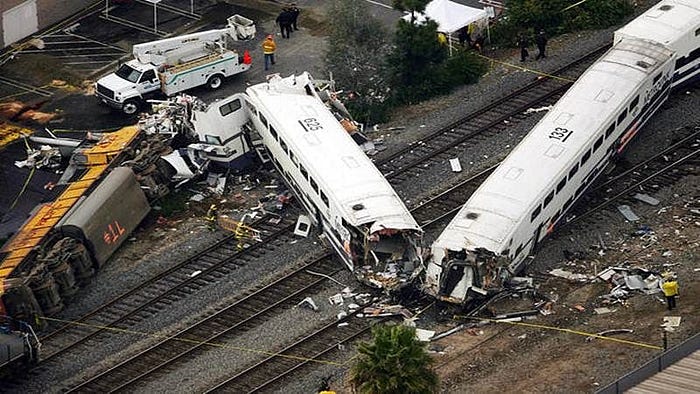
Mister Álvarez was detained and charged with eleven counts of first-degree murder with special circumstances alongside one count of arson (it was found out that he had spilled gasoline on his car). Prosecutors also sought the seldom-used charge of “train wrecking”, a law created in the 1870s to prosecute train robbers in the wild west. During the trial his defense maintained that the crash wasn’t homicide but an accident, that he had only meant to kill himself and not harm anyone else. Prosecutors countered this by saying he had deliberately wanted to cause a train crash to get attention from his estranged wife, who had filed a restraining order against him a few months prior citing erratic and threatening as well as overly controlling behavior. It hadn’t been his first attempted suicide, having been treated for consequences of failed attempts before as well as having a history of methamphetamine-abuse. On June 26th 2008 Álvarez was acquitted of the train-wrecking charge, two weeks later he was sentenced to 11 consecutive life sentences without the possibility of parole. He is interned at a Level 4 maximum security prison in Delano, California.
In 2009 a number of survivors and victims’ relatives filed a negligence lawsuit against Metrolink, citing poor training had led to a delayed activation of the emergency brakes. By December of that year Metrolink had, by their own statement, paid out 39 million USD in settlements and was in the process of investing over 500 million USD in new and safer rolling stock, better training, dashcams for the trains and upgrades to their infrastructure.
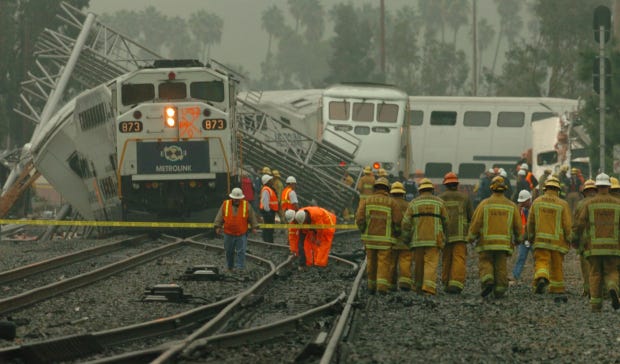
While most of the train cars were scrapped after the accident all the locomotives involved were repaired and returned to service, including the freight train’s locomotive which had fallen over after suffering severe damage to its nose section.
In the years following the accident Metrolink retired or sold almost all their F59-locomotives. #873, the locomotive pushing the southbound train, received new engines with lower emissions and was turned into the F59PHR for shunting work while its northbound counterpart was placed in indefinite storage a few years after the accident. In 2015 Metrolink took delivery of the new EMD F125 “Spirit”, meant to finally retire the last F59s from commercial services. Already in 2010 did Metrolink start taking delivery of 56 Hyundai Rotem bilevel cab cars, which offer drastically improved structural engineering. The crash engineering was such an important part of the new cars’ engineering that their full name reads “Hyundai Rotem Bi Level crash energy management cars”. The new cab cars are compatible with the older Bombardier cars, but long-term matching bilevel cars will replace the Bombardier ones. Metrolink has already retired over 30 first and second generation Bombardier cab cars, some of which temporarily re-entered service after removal of the control desk. The new cab cars feature a distinct driver’s cab on the upper level, protruding from the end of the passenger area, as well as a more aerodynamic and locomotive-like appearance.
While derailments from striking cars stranded on train tracks have happened before, sometimes with similarly catastrophic chain reactions, and can’t be completely avoided in the future the lessons learned at Glendale still improved railway safety for smaller-scale accidents.
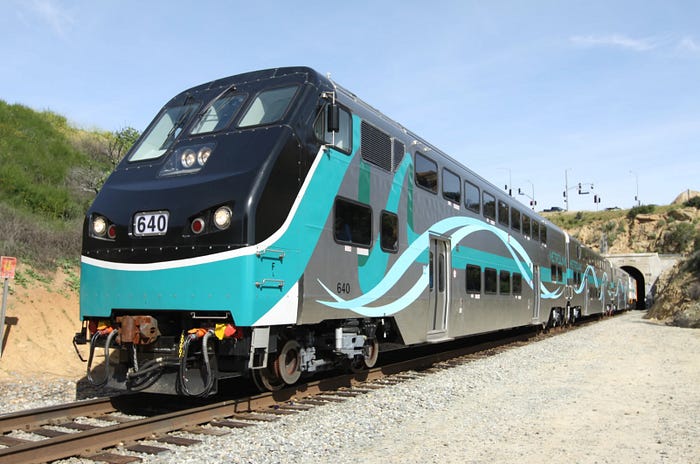
_______________________________________________________________








